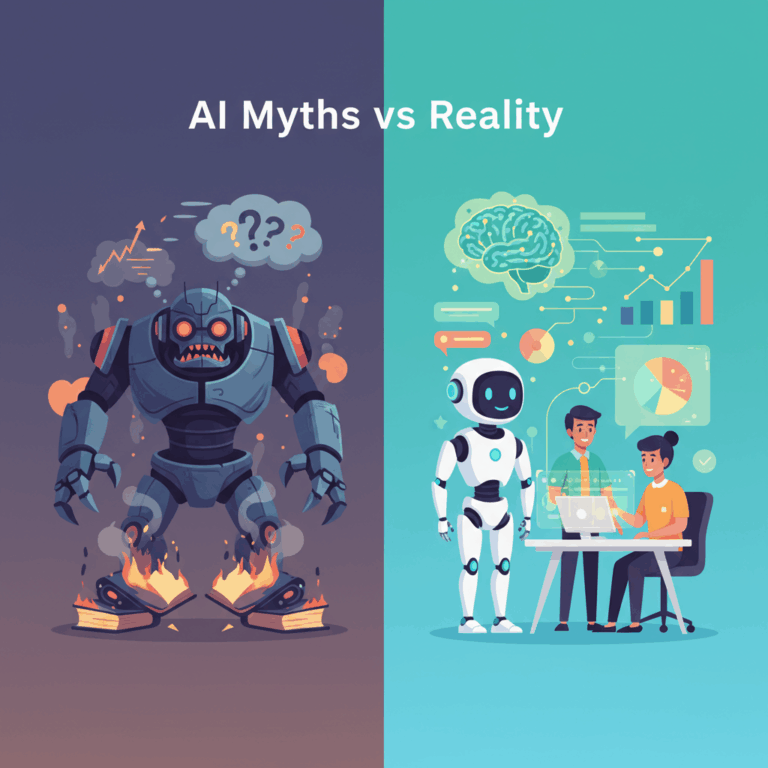Foundational Misconceptions about AI
Many people hold misconceptions about AI that shape how they perceive and use this technology in daily life. These myths often lead to unrealistic expectations and fears.
Understanding the difference between AI myths and reality is crucial for making informed decisions about its practical applications and limitations in various fields.
Two of the most common misunderstandings involve AI’s supposed sentience and creativity, themes that often appear in popular media but lack factual basis.
AI and Sentience
AI systems do not possess consciousness or self-awareness. They function by analyzing patterns in data without emotions or genuine understanding.
Despite some portrayals of AI as sentient beings, current AI lacks any form of subjective experience or motivation; it operates purely on programmed algorithms.
This means AI cannot feel, think, or desire anything like humans do. It is a tool designed to process information systematically without awareness.
AI and Creativity
While AI can produce outputs that seem creative, this is the result of mimicry rather than true inspiration or original intent. AI generates content based on learned data patterns.
Its creativity is an illusion—AI models remix and combine existing information rather than inventing genuinely novel ideas or concepts.
Therefore, AI’s “creativity” depends entirely on human-designed inputs and data, lacking the spontaneity and emotional depth involved in human artistic processes.
Transparency and Human Interaction with AI
Despite fears, not all AI models operate as mysterious black boxes. Many AI systems are designed with explainability in mind, allowing users to understand their decisions and processes.
Clear communication about AI enhances trust and allows humans to collaborate effectively with machines rather than fearing or distrusting them.
Human interaction with AI is evolving from simple automation towards cooperative partnerships where AI supports, rather than replaces, human judgment and skills.
Explainability of AI Models
Explainability varies widely across AI models. Simple algorithms like decision trees are transparent and easy to interpret, revealing the logic behind their decisions.
More complex models such as deep neural networks pose challenges, but tools and techniques now help improve their interpretability to users and developers.
Being able to explain AI decisions is crucial for accountability, ethical use, and building user confidence in AI-powered systems.
Without explainability, users might mistrust AI outcomes, leading to reluctance in adopting potentially beneficial technologies.
Interesting Fact
Explainable AI (XAI) is a growing research field dedicated solely to making complex AI systems understandable and transparent to people.
The Role of AI in the Workforce
Contrary to popular myth, AI is not poised to replace humans entirely but to augment human capabilities in the workplace.
AI handles repetitive tasks efficiently, giving people more time to focus on creativity, critical thinking, and interpersonal skills.
The integration of AI often results in new job roles and demands for human skills that machines cannot replicate, such as empathy and complex decision-making.
AI’s Human-like Thinking Myth
AI does not think like humans—it processes data patterns statistically without genuine comprehension or consciousness.
This means AI lacks intuition, emotions, or context awareness; it cannot form opinions or understand abstract concepts like humans do.
Believing AI has human-like cognition can lead to unrealistic expectations about its capabilities and ethical considerations in relying on its outputs.
Data Requirements and Accessibility
A common misconception is that AI demands enormous amounts of data to perform well. While large datasets are beneficial, AI models can adapt and learn efficiently from smaller datasets using advanced methods.
Techniques like transfer learning enable AI to leverage existing knowledge gained from one domain and apply it to new, related tasks with fewer data, increasing accessibility.
This capability reduces the barrier for smaller organizations or individuals to use AI effectively without needing vast resources or extensive data collection from scratch.
Data Needs and Transfer Learning
AI traditionally requires substantial data to train models accurately. However, transfer learning circumvents this by utilizing pre-trained models on large datasets for new, smaller tasks.
By adapting the learned features, AI systems can perform well with less data and training time, making AI more accessible across various applications and industries.
Transfer learning also helps in domains where data is scarce or costly to collect, expanding AI’s reach beyond big tech companies to smaller organizations.
Understanding these data requirements demystifies the notion that AI is only feasible with massive datasets, highlighting the technology’s practical flexibility.
Myths on AI Exclusivity and Usage
There is a common belief that AI is only accessible or beneficial to large enterprises, but this is a misconception. AI technology has become increasingly scalable and user-friendly.
From small businesses to everyday users, AI tools are readily available and integrated into many products, making them useful across a wide range of applications.
Understanding the true accessibility of AI helps demystify its use and encourages broader adoption beyond just corporations with vast resources.
AI for Large Enterprises vs. Everyday Users
AI is often thought to require massive budgets and technical expertise, restricting it to large corporations. In reality, many AI services are designed for easy use by smaller businesses and individuals.
Cloud-based AI platforms and pre-built models allow users without deep technical knowledge to leverage AI capabilities effectively and affordably.
This democratization of AI empowers a diverse range of users to enhance tasks such as marketing, customer service, and data analysis.
As a result, AI applications are no longer exclusive to large enterprises but are becoming integrated into everyday tools and workflows.
Common AI Applications in Daily Life
AI technology quietly underpins many everyday applications like voice assistants, recommendation systems, and personalized search engines, making daily tasks easier for most people.
These applications use AI to understand user preferences, provide relevant content, automate routine activities, and offer intuitive interfaces in real time.
Such integrations demonstrate that AI is already part of daily life, contrary to the myth that it is an advanced and inaccessible technology solely for specialists.






